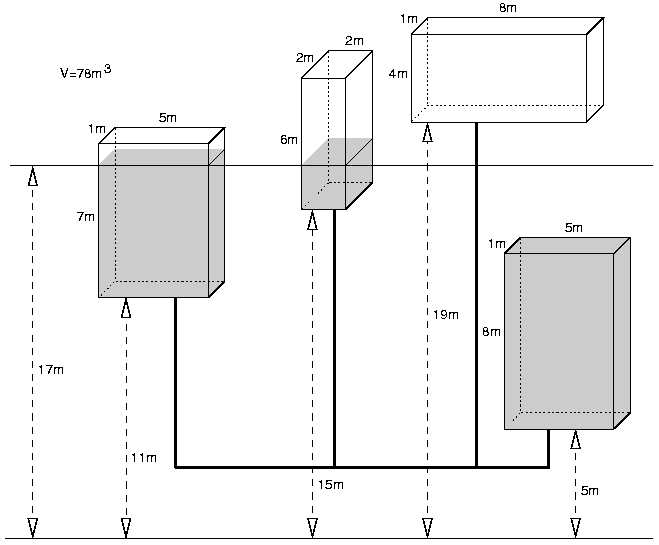|
Language:
Fill the Cisterns!
Description
During the next century certain regions on earth will experience severe water shortages. The old town of Uqbar has already started to prepare itself for the worst. Recently they created a network of pipes connecting the cisterns that distribute water in each neighbourhood, making it easier to fill them at once from a single source of water. But in case of water shortage the cisterns above a certain level will be empty since the water will to the cisterns below.

You have been asked to write a program to compute the level to which cisterns will be lled with a certain volume of water, given the dimensions and position of each cistern. To simplify we will neglect the volume of water in the pipes. Task Write a program which for each data set: reads the description of cisterns and the volume of water, computes the level to which the cisterns will be filled with the given amount of water, writes the result. Input
The first line of the input contains the number of data sets k, 1 <= k <= 30. The data sets follow.
The first line of each data set contains one integer n, the number of cisterns, 1 <= n <= 50 000. Each of the following n lines consists of 4 nonnegative integers, separated by single spaces: b, h, w, d - the base level of the cistern, its height, width and depth in meters, respectively. The integers satisfy 0 <= b <= 10^6 and 1 <= h * w * d <= 40 000. The last line of the data set contains an integer V - the volume of water in cubic meters to be injected into the network. Integer V satisfies 1 <= V <= 2 * 10^9. Output
The output should consist of exactly d lines, one line for each data set.
Line i, 1 <= i <= d, should contain the level that the water will reach, in meters, rounded up to two fractional digits, or the word 'OVERFLOW', if the volume of water exceeds the total capacity of the cisterns. Sample Input 3 2 0 1 1 1 2 1 1 1 1 4 11 7 5 1 15 6 2 2 5 8 5 1 19 4 8 1 132 4 11 7 5 1 15 6 2 2 5 8 5 1 19 4 8 1 78 Sample Output 1.00 OVERFLOW 17.00 |
题意:求将体积为V的水倒入上图所示结构水位能到达的最大高度
解题思路二分
#include<cstdio>
#include<cstdlib>
#include<cstring>
#include<algorithm>
#include<cmath>
#define eps 1e-8
#define inf 0x3f3f3f3f
using namespace std;
struct Node{
double l,h,w,d;
}A[50010];
double MIN(double a,double b){
return a<b?a:b;
}
double MAX(double a,double b){
return a>b?a:b;
}
int main()
{
int t,i,j,n;
double volum,left,right,v=0;
scanf("%d",&t);
while(t--){
scanf("%d",&n);
left=inf;right=0;v=0;
for(i=0;i<n;++i){
scanf("%lf%lf%lf%lf",&A[i].l,&A[i].h,&A[i].w,&A[i].d);
v+=A[i].h*A[i].w*A[i].d;
left=MIN(A[i].l,left);
right=MAX(A[i].h+A[i].l,right);
}
scanf("%lf",&volum);
if(volum-v>eps){
printf("OVERFLOW\n");
continue;
}
while(right-left>eps){
double mid=(left+right)/2.0;v=0;
for(i=0;i<n;++i){
if(mid-A[i].l>=0){
if(mid-(A[i].h+A[i].l)>=0){
v+=A[i].d*A[i].h*A[i].w;
}
else{
v+=A[i].d*A[i].w*(mid-A[i].l);
}
}
}
if(v>=volum){
right=mid;
}
else{
left=mid;
}
}
printf("%.2lf\n",right);
}
return 0;
}






















 322
322











 被折叠的 条评论
为什么被折叠?
被折叠的 条评论
为什么被折叠?








